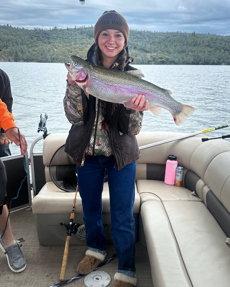[slideshow id=1419]
Trout like “cold water” and that is the reason they stay in the deep water during the summer. We raise trout in the winter and plant trout in the winter and spring since the water temperature is ideal for their survival.
Summer fish- Bass, Catfish, Crappie, and Bluegill love the warm water and are much more prominent during the spring, summer, and fall months.
As we approach the fall and the evenings start cooling down which also cools the surface of the lake we will start seeing more trout again. The threadfin shad are starting to hatch and will appear near the surface in large numbers, feeding in the sunlight on plankton. The cycle of life continues as the fish in the lake already will feed on the shad, you will notice them “breaking water” while jumping into a school of shad.
Our lake is undergoing this major transition right now and although the fishing slowed way down this last week during this process, the good news is you have lots to look forward to in the near future after the lake turns.
Jeremy Pratt of Elk Grove fished with a nightcrawler near the dam and hooked a 5 lb. 8 oz. Catfish.
Bowdy & Tracie hooked a beautiful Sunfish from the shoreline on a worm.
[nggallery id=1420]
Does the lake really turn over?
Yes. As an example, lakes stratify during the summer. The water near the bottom has less oxygen and is cooler than the water at the top. The “line” where the temperature difference is significant is called the thermocline. The sun warms the upper layer and winds allow for mixing. As the air cools during the fall, the temperature difference between the layers decreases. Now, the mixing can occur throughout the water column. Because the oxygen depleted water is mixed with the more oxygenated water, the pH and overall oxygen content of the lake will change. This is called turnover.
Why do Threadfin Shad appear on the surface during the fall?
They spawn at the end of summer and often appear on the surface in large schools in the late afternoon.
Plankton is the food source for threadfin shad. They run in schools of similar size fish and you often see them feeding on plankton right on the surface late in the day when photosensitive plankton rises to the top as the sun sets. Threadfin shad cannot withstand cold temperatures so they die off when the lake reaches low temperatures below 50 degrees in the winter months.

 Available near our general store. 45 minutes free each day.
Available near our general store. 45 minutes free each day.